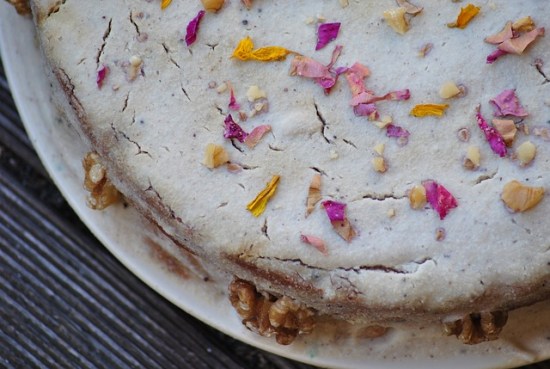How To Become More Self-Sufficient Without Starting a Full-Blown Farm…
Want to start preserving your harvest, making your own soap, or building a backyard root cellar — but not sure where to begin? “Homesteading Advice” gives you instant lifetime access to 35+ practical homesteading books on food preservation, veggie gardening, DIY natural cleaning products (save over $250 per year with this skill alone), brewing, off-grid energy, and a whole lot more…
Click Here To Check It Out Now!
Edible flowers can add visual interest, fragrance and flavor to your salads, cold drinks and meals. This guide describes easy and appealing flowers to grow and use. Make sure you have identified flowers correctly. Latin names are included since common names vary in different parts of the country.
EDIBLE FLOWERS TO GROW…
THESE GARDEN ORNAMENTALS HAVE EDIBLE BLOSSOMS:
Begonia (Begonia x tuberhybrida)
Begonia (Begonia x tuberhybrida) blooms are citrus-flavored with a mild bitter aftertaste.
Bee balm (Monarda didyma)
Bee balm (Monarda didyma) has minty-flavored flowers.
Calendula (Calendula officinalis)
Calendula (Calendula officinalis) blossoms are spicy and slightly bitter.
Day-lily (Hemerocallis species)
Day-lily (Hemerocallis species) buds and blossoms taste almost like asparagus. They can be laxative–eat them in moderation. Don’t eat flowers of other types of lily.
Hibiscus (Hibiscus rosa-sinensis)
Hibiscus (Hibiscus rosa-sinensis) flowers have a mild citrus flavor.
Nasturtium (Tropaeolum majus)
Nasturtium (Tropaeolum majus) blossoms have mild, almost mushroom-flavored petals. The rest of the flower and its stem are sharp and peppery.
Pansy (Viola x wittrockiana)
Pansy (Viola x wittrockiana) flowers have a wintergreen taste.
Sunflower (Helianthus annuus)
Sunflower (Helianthus annuus) buds are artichoke-flavored.
Violet (Viola odorata)
Violet (Viola odorata) blossoms taste sweet and aromatic.
THESE GARDEN VEGETABLES HAVE EDIBLE FLOWERS:
Arugula (Eruca vesicaria sativa)
Arugula (Eruca vesicaria sativa) has spicy blossoms. Leaves taste bitter after plants bloom.
Radish (Raphanus sativus)
Radish (Raphanus sativus) flowers are peppery.
Scarlet runner beans (Phaseolus vulgaris)
Scarlet runner beans (Phaseolus vulgaris) have mild-flavored crunchy blossoms.
Squash (Cucurbita pepo)
Squash (Cucurbita pepo) flowers are mild-flavored and sturdy enough to cook well. Harvest male blossoms (those with slender stems, not set on the end of tiny fruits). If you pick female blossoms you won’t get actual squash.
THESE HERBS HAVE EDIBLE FLOWERS:
These edible flowers taste more or less like the leaves. Don’t let all your herbs go to flower; leaf flavor is usually best before flowers emerge.
Basil (Ocimum basilicum)
Chervil (Anthriscus cerefolium)
Cilantro (Coriandrum sativum)
Dill (Anethum graveolens)
Fennel (Foeniculum vulgare)
Marjoram (Origanum majorana)
Oregano (Origanum species)
Summer Savory (Satureja hortensis)
Thyme (Thymus species)
Winter savory (Satureja montana)
THESE WILD PLANTS HAVE EDIBLE FLOWERS:
Chicory (Cichorium intybus)
Chicory (Cichorium intybus) has endive-flavored flowers best eaten raw.
Dandelion (Taraxacum officinale)
Dandelion (Taraxacum officinale) blossoms are sweet when budding or newly opened, bitter when older.
HARVESTING AND PREPARING EDIBLE FLOWERS…
Choose your flowers carefully. Make sure that you’ve identified your plants correctly. Don’t eat flowers from plants that you’ve treated with pesticides or fertilizers that aren’t food safe. Some Extension sources recommend not eating flowers from plants, which have been exposed to untreated animal manure in the past 4 months.
If you have hay fever, asthma or allergies you may wish to avoid eating flowers because of their pollen content. You might use only petals rather than whole flowers in order to avoid pollen, which can also alter the taste of the flower.
Taste-test your flowers before picking them in quantity. Use only flowers at their peak (or buds, for some varieties). Pick in the cool of the day, after dew has evaporated. Use flowers on the day when you pick them, as soon after picking as possible. Between harvest and use place short-stemmed flowers in a paper bag with a damp paper towel and store them in the refrigerator; keep long-stemmed flowers in a container of water. Flowers can also be dried and stored in airtight containers for later use.
MEALS WITH EDIBLE FLOWERS…
Herb flowers can be used like any other parts of the herb in cooking, or used as garnishes or to flavor cold drinks. Violets are also used for drink flavoring. Herb flowers and hibiscus make appealing teas.
Flowers for eating raw, solo or in salads, include arugula, calendula, chicory, dandelions, daylilies, radish blossoms, scarlet runner bean blossoms and violets.
You can bread and fry daylily buds or squash blossoms. Squash blossoms may also be stuffed with cheeses and seasonings and baked or fried.
You can steam or stir-fry dandelions, daylilies and scarlet runner bean blossoms. Sunflower buds are better steamed than stir-fried. You can cook violets as you’d cook spinach.
Violets and pansies are sometimes candied and served on top of desserts. This is done by brushing them with egg white, sprinkling them with sugar and leaving them to dry on parchment paper or wax paper. Opinions about the safety of eating dried raw egg white vary…
WANT TO LEARN MORE ABOUT EDIBLE FLOWERS FROM THE GARDEN?
For a thorough overview of edible flowers check: Choosing and Using Edible Flowers from NC Cooperative Extension
A less comprehensive quick-start guide is available at: Edible Flowers from University of Minnesota Extension
Article via GardeningChannel
If you like this idea, be sure to share it with your friends and inspire someone you know. Anything becomes possible with just a little inspiration…

